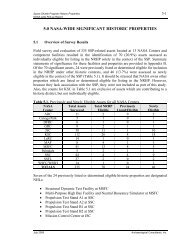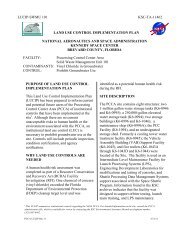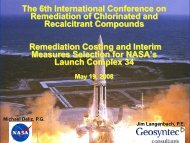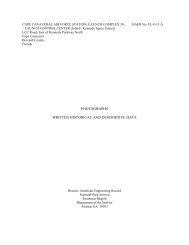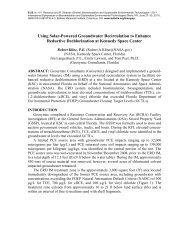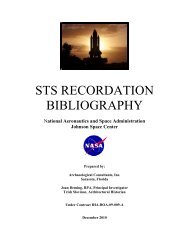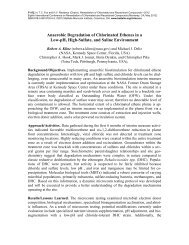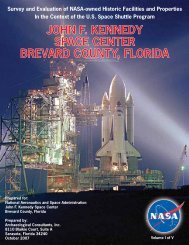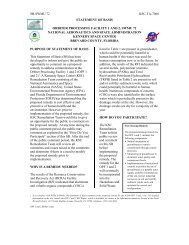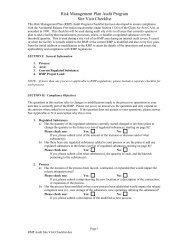HMP South & Boresight Control Building Historic Survey
HMP South & Boresight Control Building Historic Survey
HMP South & Boresight Control Building Historic Survey
Create successful ePaper yourself
Turn your PDF publications into a flip-book with our unique Google optimized e-Paper software.
HISTORY SURVEY AND EVALUATION, HYPERGOL MODULE PROCESSING SOUTH (M7-1212)AND BORESIGHT CONTROL BUILDING (M7-0867) JOHN F. KENNEDY SPACE CENTER5II. HISTORIC CONTEXTNASA AND THE SPACE SHUTTLE PROGRAMNASA was created in 1958 in response to the Soviet launch of the Sputnik satellite a yearearlier. NASA’s first series of missions were to send man into space, followed by manned orbitsaround the Earth, mastery of rendezvous and docking procedures, and finally, landing man onthe moon. These goals defined the three main programs of the late 1950s and 1960s: Mercury,Gemini, and Apollo. This effort culminated in the first moon landing, which occurred on July20, 1969. Moon landings continued until 1972 when the Apollo program ended. Programs afterApollo included the Skylab space station that orbited Earth from 1973 to 1979, and the Apollo-Soyuz Test Project, the first space mission undertaken as a joint effort between the United Statesand the Soviet Union in 1975. By the mid-1970s, it was clear that NASA’s next major programwould be based on a reusable space shuttle, designed to serve orbiting space stations and relatedmissions (Deming and Slovinac 2008:2.1; NASA 2010; NASA 2009).President Nixon established the Space Task Group in 1969 to determine the future courseof the U.S. Space Program. This led to the creation of the SSP, which was announced in aspeech by President Richard Nixon in 1972. In the speech, Nixon outlined the future of the SSPbased on the idea that a series of reusable space flight vehicles would provide “routine access tospace” (Deming and Slovinac 2008:2.1). Following this announcement, new SSP contracts wereawarded, new space vehicles were designed, old Apollo-era facilities were retro-fitted, and newfacilities were built. After a decade of preparation, the first shuttle flight occurred in 1981. Afteralmost three decades of operations, the SSP was retired in 2011.During those twenty-nine years of operation, there were over 130 different flights, usinga total of five space shuttles: Columbia, Challenger, Discovery, Atlantis, and Endeavour (theprototype, Enterprise, never went into space). The SSP achieved a number of significant goals.In addition to supporting diverse space facilities such as Spacelab, the Hubble Space Telescope,the Mir Space Station, and the International Space Station (ISS), the shuttles contributed to manyother space programs. Among these were various satellite systems (from the COMSAT,Communication Satellite to the Advanced Communications Technology Satellite, or ACTS), andthe unmanned probes that were sent to Jupiter (Galileo), Venus (Magellan), and the Sun(Ulysses). Additionally, the shuttle has deployed a number of Department of Defense (DoD)payloads that remain classified (Deming and Slovinac 2008:2.22-24).



